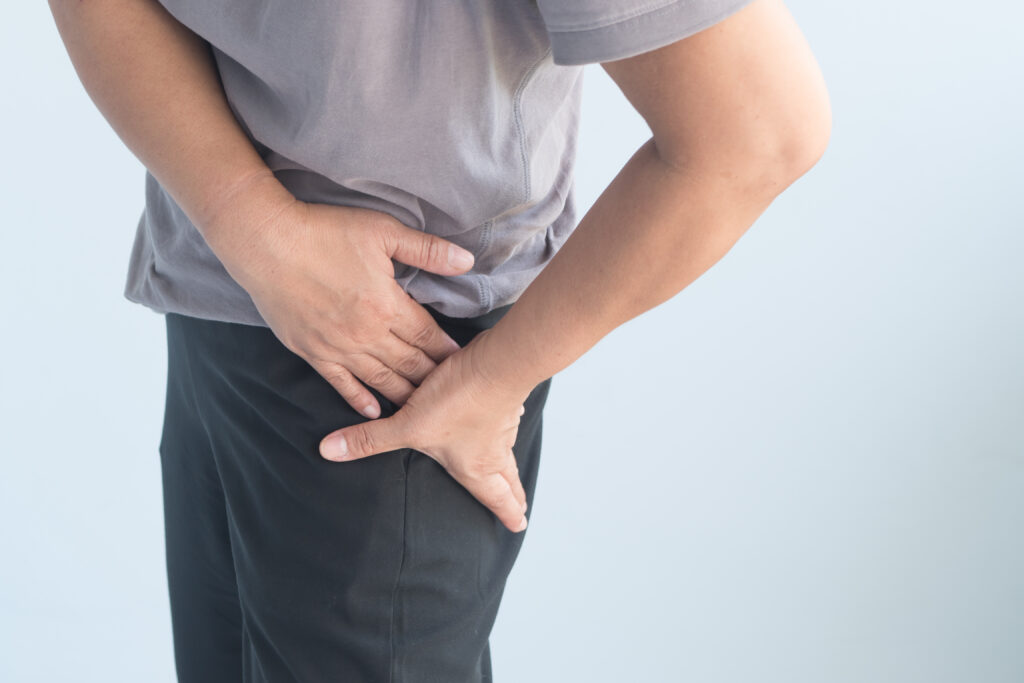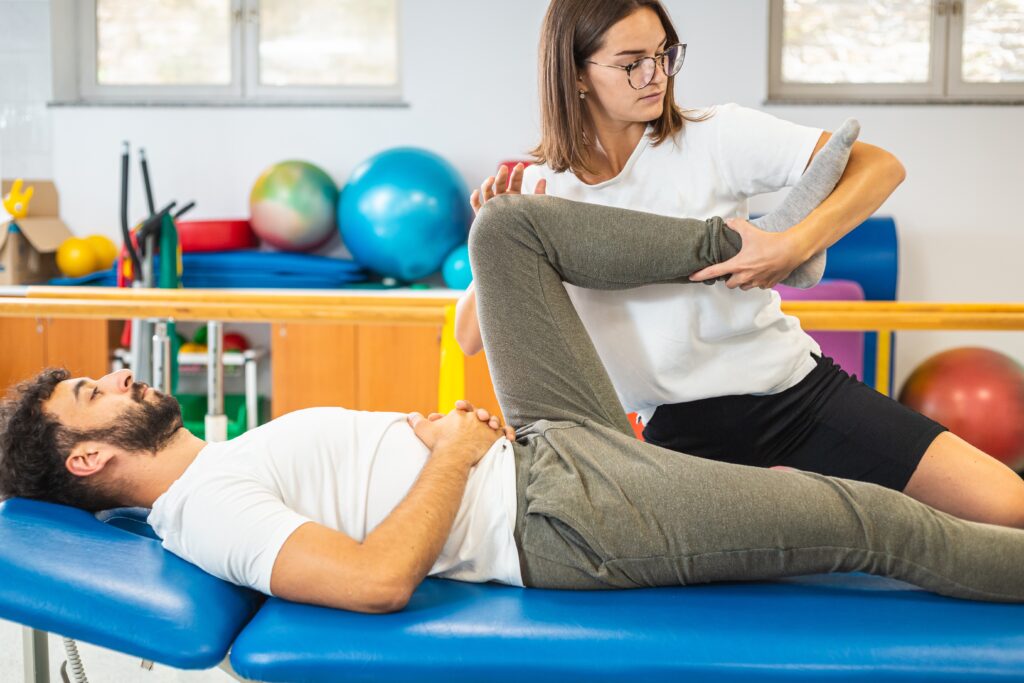July 7, 2023
What Causes Hip Pain That Radiates Down the Leg?
The hip joint—known as the “ball and socket” joint—is the largest weight-bearing joint in the body. Any problem that affects your hips can cause a significant amount of pain and discomfort, especially when that pain radiates to another part of your body, such as the legs.
Knowing the exact cause of hip pain that is radiating down your leg can pave the way for effective treatment that helps you find relief.
Here’s what causes hip pain that radiates down the leg, and how to contact Healthcare Associates of Texas if you need treatment for this issue.
5 Causes of Hip Pain That Radiates Down the Leg
Hip pain that runs down the leg can originate in the front, side, or back of your hip. Below are its top five causes.
1. Osteoarthritis
Of all the types of arthritis, osteoarthritis is the most common. Osteoarthritis is also known as degenerative joint disease.
Osteoarthritis in the hips can occur when the cartilage that cushions the ends of the bones in your hip joint gradually wears down over time. Factors that can increase your risk for osteoarthritis include obesity, repetitive stress on the joint, and age.
In addition to feeling hip pain that radiates down the leg with osteoarthritis, you may also experience other symptoms, including:
- Stiffness in the hip joint
- Reduced range of motion in the hips
- Popping or clicking sensation and noises in the hips
- Swelling near the hip joint
- Bone spurs around the hip joint
2. Labral Tear
A labral tear in the hip occurs when the cartilage that holds the ball and socket parts of the hip together becomes torn. This can happen when you play certain sports, such as hockey, football, and golf. It can also happen during a car accident, and when doing repetitive motions that involve the hips, such as twisting.
Other symptoms of a labral tear include:
- Pain in the groin and/or buttocks
- Locking, clicking, or popping sensation in the hip joint
- Stiffness in the hips
- Reduced range of motion in the hips
3. Greater Trochanter Pain Syndrome
Greater trochanter pain syndrome (GTPS) is a hip disorder that occurs when the tissues on the outside of the hip bone (known as the greater trochanter) become irritated and inflamed.
Repetitive hip movements, obesity, and lack of exercise can cause GTPS. Hormone changes and an injury to the side of the hip may also cause it.
This hip disorder can cause hip pain that runs down the thigh and leg. Other symptoms of GTPS may include:
- Pain in the back and/or buttocks
- Pain that gets worse when you exercise
- Tenderness of the hip joint
4. Sciatica
Sciatica refers to conditions that cause you to feel pain along the sciatic nerve. The sciatic nerve runs from the lower back and down through your hips, buttocks, and each of the legs.
A herniated disc is the most common cause of sciatica. A herniated disc in the spine can put extra pressure on the sciatic nerve to cause mild to severe pain. Sciatica may also be caused by bone spurs that form on spinal bones.
Risk factors for sciatica include obesity, diabetes, sitting for long periods, and repetitive movements such as twisting the back.
In addition to causing pain along the sciatic nerve, sciatica may cause symptoms including:
- A jolt or electric shock sensation
- Pain that gets worse when coughing or sneezing
- Numbness and tingling in the affected leg or foot
- Muscle weakness in the leg
5. Hip Impingement
Hip impingement occurs when the ball part of the hip (known as the femoral head) pushes up against the cup part of the hip (called the acetabulum). This can damage the cartilage surrounding the acetabulum and cause hip pain radiating down the legs.
Hip impingement usually begins at birth or during childhood due to the growth of extra bone that prevents the hip bones from coming together normally. Kids who develop hip impingement usually play sports that involve lots of squatting and twisting of the hips.
Other symptoms of hip impingement may include:
- Pain around the hips and groin that comes and goes
- Dull ache in the hip or groin when relaxing
- Sharp pain when squatting, bending, and/or twisting
How to Treat and Relieve Hip That Pain That Goes Down the Leg
The key to finding relief from hip pain that travels down the leg is identifying its root cause. Then, your doctor can work with you to find the proper treatment. For example, if excess weight is causing your hip pain, your doctor may recommend losing weight with diet or exercise.
In many instances, getting plenty of rest and avoiding activities that stress the hip joint can relieve your pain. However, you may want to see your doctor first to make sure getting rest will help your pain go away.
Osteoarthritis Treatments
Osteoarthritis can usually be managed with over-the-counter (OTC) pain relievers and physical therapy. If these treatments don’t work, your doctor may recommend injections of cortisone or hyaluronic acid injections that can reduce pain. You may need surgery to repair or replace the hip joint in severe cases.
Labral Tear Treatments
A hip labral tear may be managed using OTC pain relievers, physical therapy, or surgery in severe instances. Surgery for a hip labral tear may involve removing the torn cartilage or repairing it by sewing it back together.
GTPS Treatments
GTPS may be managed using OTC pain relievers, opioids, or corticosteroid injections. Your doctor may also recommend avoiding any activities that worsen your pain.
Sciatica Treatments
 Sciatica may be treated using one or more medications, including opioids, antidepressants, and corticosteroids. Your doctor may also prescribe drugs that reduce inflammation.
Sciatica may be treated using one or more medications, including opioids, antidepressants, and corticosteroids. Your doctor may also prescribe drugs that reduce inflammation.
If your sciatica is severe and causing weakness or loss of bowel or bladder control, your doctor may recommend surgery. Surgery for sciatica usually involves removing the herniated disc or bone spur causing your symptoms.
Hip Impingement Treatments
Physical therapy and OTC pain relievers are usually the first-line treatments for hip impingement. In severe instances, surgery may be performed to repair damaged cartilage and tissue, or to remove extra bone.
When to See a Doctor
It’s time to make an appointment with your doctor if your hip and leg pain doesn’t go away or if it worsens suddenly or over time. Another sign it’s time to see a doctor is if you’re experiencing loss of bladder or bowel control (which can happen with sciatica).
Your doctor can perform an exam, review your medical history, and discuss your symptoms and lifestyle to determine why you’re experiencing hip pain. Your provider may also run one or more diagnostic tests to identify the source of the problem. X-rays, CT scans, and MRIs are common tests your doctor may use to diagnose your hip and leg pain.
Request an appointment with Healthcare Associates of Texas today to receive treatment for any medical issue, including hip pain that radiates down the leg. We offer high-quality healthcare services, including primary care, imaging, sleep medicine, and much more!
References
- Centers for Disease Control and Prevention. 2020. “Osteoarthritis (OA).” Centers for Disease Control and Prevention. July 27, 2020. https://www.cdc.gov/arthritis/basics/osteoarthritis.htm.
- Groh, Megan M., and Joseph Herrera. 2009. “A Comprehensive Review of Hip Labral Tears.” Current Reviews in Musculoskeletal Medicine 2 (2): 105–17. https://doi.org/10.1007/s12178-009-9052-9.
- Pumarejo Gomez, Laura, and John M. Childress. 2021. “Greater Trochanteric Syndrome.” PubMed. Treasure Island (FL): StatPearls Publishing. 2021. https://www.ncbi.nlm.nih.gov/books/NBK557433/.
- Davis, David, and Arvind Vasudevan. 2019. “Sciatica.” Nih.gov. StatPearls Publishing. November 15, 2019. https://www.ncbi.nlm.nih.gov/books/NBK507908/.
- “Femoroacetabular Impingement – OrthoInfo – AAOS.” 2015. Aaos.org. 2015. https://orthoinfo.aaos.org/en/diseases–conditions/femoroacetabular-impingement/.
DISCLAIMER
The information featured in this site is general in nature. The site provides health information designed to complement your personal health management. It does not provide medical advice or health services and is not meant to replace professional advice or imply coverage of specific clinical services or products. The inclusion of links to other web sites does not imply any endorsement of the material on such websites.
Ready to become your healthiest self?
Get tips delivered to your e-mail inbox every month. Let’s get happier and healthier together!



